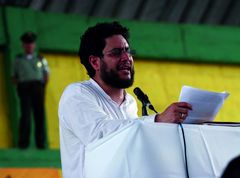
Iván Cepeda at a public hearing in San Onofre. He spoke against the ties between politicians and paramilitarism. [Photo: Sebastian Rötters]
Article published in the special Newsletter '15 years of PBI', October 2009
Rokko Fermo, volunteer from Italy (2009)
On 6 March 2008, nearly 300.000 persons march in homage to the victims of paramilitarism, para-politics 1 and State crimes.
Iván Cepeda –the son of Senator Manuel Cepeda, the director of the Cepeda Foundation and member of the National Movement for Victims of State Crimes (MOVICE), discusses the march for the rights of victims of paramilitarism that took place on 6 March 2008. PBI has accompanied the Cepeda Foundation since April 2004 when Iván Cepeda and co-founder Claudia Girón returned to Colombia after more than four years of exile in France, due to the death threats they had been receiving.
PBI: The march on 6 March was a success. Can you tell us how many people participated?
Iván Cepeda: Estimates reached a figure of close to 300.000 people who mobilised in almost 100 cities in Colombia and throughout the world 2.
PBI: How were you able to mobilise so many people?
IC: I believe it had to due with properly understanding the time in which the demonstration took place. In Colombia, crimes committed by state agents have been historically concealed and silenced. However, at the time of the demonstration, a favourable situation existed to begin awakening the solidarity of citizens with respect to these criminal acts: the para-politics scandal, the initial documentation of executions committed by members of the security forces, and the Uribe administration’s involvement in crimes against humanity. All these factors that in some way were being timidly mentioned by the press and television gave rise to a situation that made it very difficult to keep hiding the fact there are victims of State agents. With much effort and in the midst of a very difficult situation, this reading allowed us to visibilise the situation of the victims of state agents.
I believe this was the beginning of a process that has gradually allowed recognising State crimes and the victims of State actors. The march is a significant reflection of the victims’ public actions. It has also given rise to other more recent events that have allowed their public visibility and, consequently, improved conditions for demanding and enforcing the rights to truth, justice and reparation.
PBI: What is the MOVICE? How did it begin?
IC: The Victims’ Movement is essentially a social movement. This means it is a manifestation of different networks and expressions, organisations, communities and persons who feel they are victims of State agents and paramilitaries. The Victims’ Movement is part of a broad spectrum of Colombian social movements and organisations that work for substantive transformations in society and toward change in the political and socio-economic system. Its specificity is that it deems justice –judicial and social—and the truth of the crimes to be factors for democratising Colombian society.
I believe the Victims’ Movement has been the political and social subject that has allowed victims in Colombia –particularly the victims of state agents—to begin to exercise and demand their rights and to more realistically aspire to wielding political power. I believe this harsh reality, which has worsened, may no longer be concealed or despised. The movement will be an important vector in this struggle through mobilisations, as well as through the formation and creation of political ideals that allow victims, along with other social movements, to attain their desired transformations.
PBI: What are the challenges and risks faced by MOVICE?
IC: Basically, the social movement faces a criminal State structure in Colombia. Moreover, this unified and integrated structure derives from organised crime. As opposed to other forms of State criminality that persecute the opposition and silence sectors of civil society, in this case a State criminality –as a structure and apparatus- is also very involved in drug-trafficking. This means that power is fragmented and can therefore have multiple forms of aggression and persecution. It is a very powerful structure with media collusion that silences, manipulates and seriously distorts its essence. This is why the MOVICE faces considerable challenges. The movement confronts these challenges by collectively constructing an opposition with international support networks, as is done in the human rights movement.
--
1 Ties between politicians and paramilitary organisations
2 70 cities in Colombia and 30 different cities in Europe, Australia, Canada and United States.
